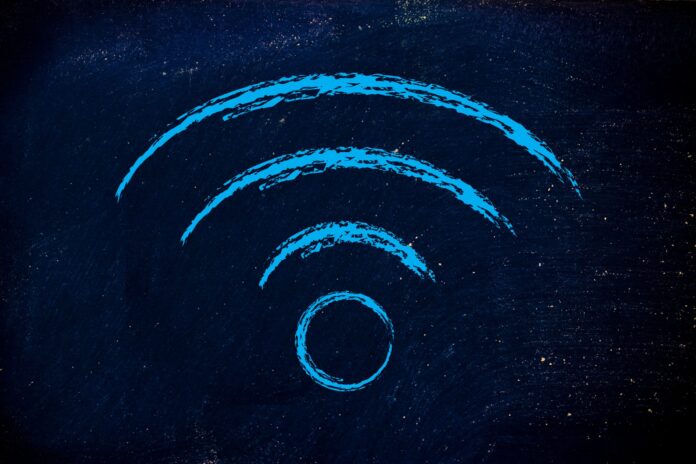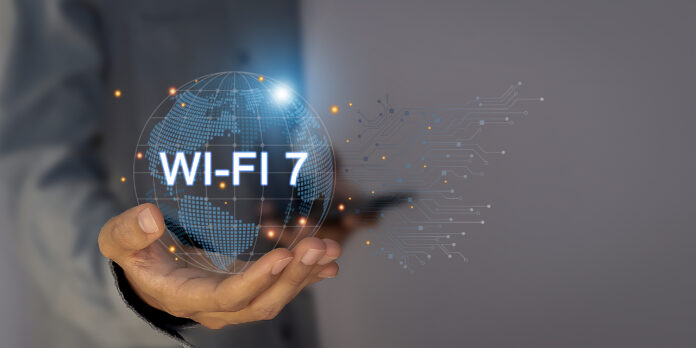WiFi driving Telco growth
Sponsored by![]()
NOTE FROM THE EDITOR

Catherine Sbeglia Nin
August 11, 2025
RCRTech Trend: Wi-Fi 7 is emerging as a new growth engine for telcos
Telcos are turning to Wi-Fi 7 for its speed, reliability and low latency to power next-gen services. From enabling whole-home gigabit coverage to unlocking consumer and enterprise IoT potential and monetization strategies, Wi-Fi 7 is emerging as a foundational tool for operators to differentiate, partner and grow in competitive broadband markets.
Three takeaways:
-
- Telcos See Wi-Fi 7 as strategic infrastructure
Operators are positioning Wi-Fi 7 as a critical enabler of premium services, from gigabit-speed home broadband to advanced enterprise solutions — shifting Wi-Fi from a customer convenience to a core network asset.’ - Increased reliability leads to new revenue streams
Wi-Fi 7’s improved performance and reliability open doors for monetization, including managed Wi-Fi services, premium-tier home connectivity and industrial IoT applications — especially when paired with 5G and fiber backbones. - Partnerships will be key to scaling
Strategic collaborations, like AT&T’s partnership with Karrier One, signal that telcos are looking to ecosystems — not just equipment — to rapidly deploy and scale Wi-Fi 7 offerings across homes, enterprises and edge environments.
- Telcos See Wi-Fi 7 as strategic infrastructure

Managing Editor

How does Wi-Fi 7 create new revenue opportunities for telcos?

Catherine Sbeglia Nin
March 3, 2025
Providers are using Wi-Fi 7 to ensure that their customers are getting the gigabit or multi-gigabit service they’re advertising
Wi-Fi 7 is the most reliable version of the technology to date, and as a result, service providers can tap into this technology to better ensure that the gigabit or multi-gigabit service they’re advertising is being provided consistently throughout their subscribers’ homes. And then, on top of that enhanced connectivity, service providers can offer new, premium services.
At the Wi-Fi Forum, David Zhang, the North America Wi-Fi Lead at Nokia explained that today, service providers rely on Wi-Fi routers to terminate broadband connections at the edge of the home and then for mesh technology to propagate that connectivity “corner-to-corner throughout the home.”
He continued: “Something that most operators, and even network equipment vendors, are trying to explore [is] how do we add additional premium services that deliver value to the subscribers, generate new revenues and ensure that end user broadband needs are being met by the network?” He noted that specific services like cybersecurity and parental controls are particularly attractive, while another key category of offerings is around Wi-Fi sensing. “We are looking at putting in these devices Wi-Fi sensing, the ability to detect motion using [radio frequencies] generated by Wi-Fi that turn your routers, your equipment already delivered to your home.” Doing do would enable things like traffic prioritization for users working from home or for those that like to game. The equipment can sense when someone is on a video call or is playing a game and gaming can “automatically route traffic to the shortest hop to minimize latency and deliver a superior… experience,” said Zhang.
In Europe, for instance, French-based telco Orange recently announced the commercial launch of Wi-Fi 7 in its Polish market and sees Wi-Fi 7 as broader opportunity to offer its customers “more than bandwidth,” according to the company’s Senior Vice President of Home Services Innovation Chem Assayag. “Today it’s about… security, stability of the connectivity in the home space, band steering… so it’s bandwidth plus a set of features, which are really important to our customers,” he told Wi-Fi Forum attendees. “Connectivity in the home is the foundation to bring new value-added services and hopefully be able to monetize them.” He, too, said that home security and sensing-based services are emerging as the most popular, and therefore, potentially profitable.
T-Mobile US’ Senior Vice President of Broadband Rob Roy, added that there is also a possibility to offer higher prices for premium subscriber tiers, with gamers of course being the prime example. Wi-Fi 7, he said offers a lot for telcos, from congestion reduction for efficiency and latency improvements. “From the carrier perspective, I think that does a couple of things, which we’re really excited about: One, it just enhances the customer experience… [by providing] faster, more reliable home broadband. That can be a differentiator… [Two,] the new offerings… There are potential premium tiers for gamers, for smart home enthusiasts and those types of things… And then just the ability to think about if you go back to those new service offerings, enabling private networks, different slices … for enterprise… we can start to create a hybrid 5G/Wi-Fi 7 ecosystem.”
Sponsored by![]()

How will Wi-Fi 7 deliver whole-home gigabit connectivity?

Catherine Sbeglia Nin
March 3, 2025
Spirent’s Principal Product Manager says that Wi-Fi 7 can finally deliver the speeds that ISPs promise — all the way to the end user
During a presentation at the Wi-Fi Forum, Janne Linkola, principal product manager in Spirent’s Automated Test & Assurance business unit, said that while mesh networking is not a topic commonly associated with Wi-Fi 7, the company actually sees it as one of the most impactful innovations that the next generation of Wi-Fi brings.
He explained that when purchasing internet service, consumers are often presented with different speed tiers. On the high end, these tiers can reach up to 1 gigabit per second (Gbps), while lower-end options range between 100 to 150 megabits per second (Mbps). However, these speeds are typically measured at the modem, meaning they represent the point at which the Internet Service Provider (ISP) hands off data to the Wi-Fi network — not the actual speeds experienced throughout the home.
The reason for this discrepancy is simple: Wi-Fi performance varies based on distance and obstacles. Linkola elaborates: “Wi-Fi has this magical ability — on the one hand it can operate really fast, and it also operates at a good distance, but it doesn’t do those two things simultaneously. One comes at the price of the other.” This is typically represented as a rate adaptation graph, which is a visual representation of how a network dynamically adjusts its data transmission rate based on channel conditions, showing the relationship between metrics like distance, signal strength, data rate and network performance.
Further, because many homes receive their internet service through a modem located in a basement or a central utility room, Wi-Fi signals often struggle to provide strong coverage on upper floors. To address this, mesh networking systems have become increasingly popular. “In a normal home… internet often comes into your home through the basement,” said Linkola. “What that means is that coverage on the first floor and especially on the second floor, may not be that great. This is where mesh systems come in. You can take an extender and put it into a more convenient place and as long as your backhaul works well, your home is covered.”
ISPs began promoting mesh systems around 2017–2018, but early extenders were relatively basic and inexpensive, often built with low-power 2×2 antenna designs. These early solutions had significant limitations, including bandwidth reduction. “The extenders that were deployed were kind of low end and relatively inexpensive — they were often based on a low power 2×2 design… and so your rate adaptation might be your television is getting 700 megabits per second when it’s close to the access point, but anything coming through a dual-band extender, basically the speed is automatically halved because every packet is sent twice — once over the fronthaul and once over the backhaul. This is what those early mesh systems could do, about 300 megabits per second, give or take,” provided Linkola.
Additional issues with these mesh systems include poor airtime fairness and ineffective client steering, both of which contributed to performance inconsistencies.
Wi-Fi 7 changes the mesh game thanks to a few key features:
- Higher modulation and faster speeds—The new 320 MHz channels and multi-link operation (MLO) provide much more robust connections.
- Wider channels, better backhaul—Using multiple wide channels in MLO results in stronger, more stable connections.
- Improved rate adaptation—With MLO-enabled extenders, speeds can now reach 16 Gbps at close range. More importantly, even at significant signal degradation (100 decibels, or dB, path loss), speeds can remain at 1 Gbps.
“Wi-Fi 7 brings a lot of elements to the picture that have the potential to change this — the modulation itself is more robust and has faster speeds, but really it’s the 320 MHz channels and multi-link operation,” said Linkola.”If you operate two really wide channels in a multi-link operation, you get a very robust link. The impact of that, looking at the rate adaption curve, if you build an MLO-enabled extender, suddenly you get 16 gigabits per second if you’re close by… but what’s really the focus of the picture… you’ll get a gigabit per second over a 100 dB of path loss.”
These improvements mean that Wi-Fi 7 can finally deliver the speeds that ISPs promise, all the way to the end user. With a properly designed MLO-enabled mesh system, users will experience 1 Gbps speeds across their entire home, even at long distances from the router.
Additionally, easier installation makes these systems more consumer-friendly. Instead of requiring a technician, users can now install extenders themselves, making whole-home gigabit connectivity more accessible and affordable.
Ultimately, Wi-Fi 7 represents a significant step forward in ensuring that consumers actually experience the high-speed internet they are paying for. “We are finally delivering the speeds to the end user that we claim that we are delivering,” concluded Linkola.
Sponsored by![]()

How will Wi-Fi 7 support the future of IoT?

Catherine Sbeglia Nin
March 3, 2025
With powerful features like 320 MHz channels, 4096-QAM modulation and Multi-Link Operation, Wi-Fi 7 has been positioned as a potential game changer for IoT
The latest numbers for global connected Internet of Things (IoT) devices show a rapidly expanding ecosystem. According to IoT Analytics, there are approximately 18.8 billion IoT devices globally, marking a 13% increase from 16.6 billion in 2023. This growth trend is expected to continue, with projections estimating that the number of IoT devices will reach 40 billion by 2030. With powerful features like 320 MHz channels, 4096-QAM modulation and Multi-Link Operation (MLO), Wi-Fi 7 has been positioned as a potential game changer for IoT as it promises to deliver the faster, more reliable, more energy efficient and lower-latency wireless connectivity that emerging — and more advanced and data-intensive — IoT applications require.
According to Quectel’s Wi-Fi Product Manager Lazaros Kapsias, MLO is a crucial enhancement for IoT because traditional Wi-Fi devices could only connect to a single band at a time. “With Multi-Link Operation, an access point is no longer restricted to communicating with a station on a single band or channel. Instead, both can use multiple channels simultaneously, enabling load balancing and dynamic interference mitigation,” Kapsias told RCR Wireless News, adding that one example includes a latency-sensitive VoIP connection moving to a low-interference channel, while a large file transfer can be distributed across two bands.
“As a result, MLO not only increases overall speed but, more importantly, reduces latency and enhances reliability. This makes it ideal for emerging applications such as VR/AR, online gaming, remote work and cloud computing,” he added.
Wi-Fi 7’s 320 MHz channels and 4096-QAM modulation provide up to four times the capacity and data rates compared to Wi-Fi 6. This is particularly beneficial for IoT applications that require high data throughput, such as smart factories leveraging real-time AI-driven automation and healthcare IoT devices transmitting high-resolution patient data.
Kapsais did note that access to the 6 GHz band is necessary to achieve the congestion benefits from 320 MHz channels. While Wi-Fi 6E introduced 6 GHz, Wi-Fi 7 fully leverages it for channel bonding and interference reduction, making it ideal for high-density IoT deployments. “Most notably, 320 MHz contiguous channels can only be achieved within the 6 GHz band — three non-overlapping ones are available in some regions,” he said.
Kapsais additionally pointed out that higher data rates are not necessarily the most critical benefit for IoT. “The reality is that the data rates of Wi-Fi 6/6E — let alone Wi-Fi 5—are already more than sufficient for the vast majority of IoT applications,” he explained. Instead, he reiterated the Wi-Fi industry mantra that the real advantage of Wi-Fi 7 lies in its efficiency and reliability.
Traditional Wi-Fi networks struggle with unpredictable latency, which can disrupt time-sensitive IoT applications. Wi-Fi 7 introduces deterministic performance, ensuring that data is transmitted with minimal jitter and packet loss. This is particularly important for:
- Industrial IoT (IIoT): Enabling precision robotics and machine-to-machine (M2M) communication in manufacturing.
- Autonomous vehicles: Supporting real-time V2X (Vehicle-to-Everything) communication for safer transportation systems.
- Smart homes & healthcare: Guaranteeing uninterrupted operation of critical systems like security alarms and remote patient monitoring.
Further, Wi-Fi 7 will also mitigate network congestion as more and more IoT devices are connected thanks to the standard’s enhanced Orthogonal Frequency Division Multiple Access (OFDMA) and Multi-User Multiple Input Multiple Output (MU-MIMO), which allows multiple IoT devices to communicate simultaneously without interference and adaptive preamble puncturing, which enables better spectrum utilization, especially in environments with competing wireless signals.
Ultimately, Wi-Fi 7 is poised to become the backbone of next-generation IoT deployments; however, Kapsais emphasized that its adoption in IoT may take longer than expected. While high-end consumer devices are already integrating Wi-Fi 7, many IoT products are still transitioning to Wi-Fi 6/6E. “For most IoT products, Wi-Fi 7 will only become relevant in their next design cycle — likely two to three years from now,” he said. “I don’t expect Wi-Fi 7 to become the dominant Wi-Fi technology in the IoT segment, in terms of units sold per year, much earlier than 2030. If we extrapolate this trend to Wi-Fi 8 — based on historical adoption patterns — the corresponding timeframe is likely somewhere between 2035 and 2040.”
Sponsored by![]()

AT&T’s Wi-Fi strategy gets a boost with Karrier One partnership

Catherine Sbeglia Nin
March 3, 2025
As user behavior continues to shift mobile data consumption toward Wi-Fi, telcos like AT&T are doubling down on Wi-Fi offload strategies
A new partnership between AT&T and Karrier One, announced today, aims to significantly expand global Wi-Fi offload coverage while pushing the boundaries of decentralized mobile connectivity. The collaboration builds on AT&T’s existing global Wi-Fi footprint by integrating it with Karrier One’s decentralized wireless (DeWi) infrastructure. The result is a growing, interoperable network of Wi-Fi access points that gives mobile users more opportunities to seamlessly offload data traffic from cellular networks to Wi-Fi — while preserving security and quality of service.
This expansion comes at a critical time, as new data from OpenSignal reveals that Wi-Fi is already doing the heavy lifting when it comes to smartphone data usage. The study, which analyzed five major U.S. mobile service providers — Verizon, T-Mobile, AT&T, Spectrum Mobile, and Xfinity Mobile — found that Wi-Fi accounts for the vast majority of users’ mobile data consumption. In fact, for AT&T users, 86% of their total data usage happens over Wi-Fi, with 81% of usage still occurring on Wi-Fi even when users are away from home.
“Wi-Fi networks shoulder the brunt of our users’ phone data usage,” wrote OpenSignal researchers Rupert Bapty and Andrey Popov, who noted that smartphone users spend three times more screen-on time at home than on the go. But even when outside, users appear to default to Wi-Fi whenever it’s available.
This behavior isn’t uniform across all operators but shows a clear trend. Cable MVNOs like Xfinity Mobile top the list with a staggering 89% of data consumed over Wi-Fi, compared to 84% for Verizon and 82% for T-Mobile. The reasons vary — from improved indoor coverage and higher speeds to the continued prevalence of data-capped plans, particularly among MVNOs.
Telcos are responding to these trends in different ways. At RCR Wireless News’ Wi-Fi Forum, T-Mobile’s Senior VP of Broadband Rob Roy stated that the company is actively exploring how to shift more mobile data onto next-generation Wi-Fi 7 networks. The goal? Enhance customer experience through faster speeds and improved signal quality indoors.
AT&T, for its part, has taken a more hands-on approach by deploying and managing its own Wi-Fi networks in densely populated urban areas. This enables tighter integration with its core telecom infrastructure, ensuring that offloaded traffic maintains carrier-grade security, performance and reliability.
Now, with Karrier One in the mix, AT&T is extending its Wi-Fi reach even further through a blockchain-based DeWi model that allows independent operators to contribute Wi-Fi coverage.
“As telecom continues to evolve, AT&T recognizes the importance of alternative infrastructure models to expand coverage, improve user experience, and reduce costs,” said Karrier One CEO Samer Bishay. “This agreement is a testament to the power of Wi-Fi offload combined with Web3 innovation, ensuring that subscribers can stay connected, whether they’re at home or traveling internationally. By embracing DePIN, we’re not just enhancing connectivity, we’re shaping the future of decentralized telecom infrastructure, making networks more resilient, efficient, and accessible for everyone.”
As Wi-Fi offloading becomes more central to network strategy, this AT&T-Karrier One partnership exemplifies how legacy carriers and emerging tech players are finding common ground to serve evolving user behavior — and, in doing so, reshape the mobile data landscape.


